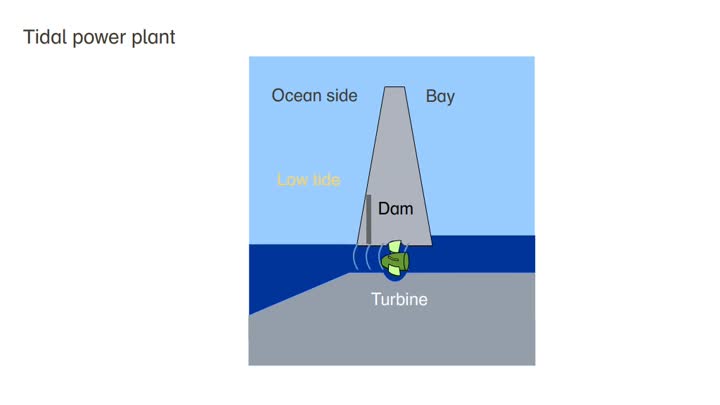Type of media:
Video (66.7 kByte)
Last update:
2018-11-28
License:

This medium is made available under a CC BY-SA 4.0 international license.
What does this mean?
How to reference this medium

This medium is made available under a CC BY-SA 4.0 international license.
What does this mean?
How to reference this medium
Media package:
Description:
A tidal power plant makes sense if the height difference between high and low tide is very large. The first (since 1966) and largest tidal power plant is located in Saint-Malo, France (240 MW, 600 million kWh of electricity per year). There are others (or others are planned) in Canada, Russia, and China. The tidal power plant harnesses the power of the enormous water movements during high and low tide. For this purpose, a dam is built across a bay or the mouth of a river and turbines are installed inside the dam. At high tide, the water flows from the ocean side into the bay through the turbines. At low tide, the water flows in the opposite direction and also drives the turbines. Primarily Kaplan tubular turbines are used in this case. Other tidal power plants do without a dam; instead of making use of the height difference of the tides, they take advantage of the currents produced by the tides (“tidal current power plant”).
Learning resource type:
Simulation
Subjects:
Geography; Personal, social and health education (PSHE); Physics; Technology
Grade levels:
Grade 1 to 4; Grade 5 to 6; Grade 7 to 9; Grade 10 to 13
School types:
Elementary school; Middle/high school; Vocational training
Keywords:
Ecology; Environmental change; Environmental protection; Hydroelectric plant; Power generation; Renewable energy; Turbine; Electric power generation; Whiteboard-compatible
Bibliography:
Siemens Stiftung Media Portal
Author:
MediaHouse GmbH
Rights holder:
© Siemens Stiftung 2018



